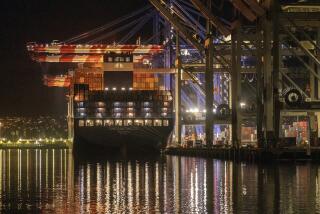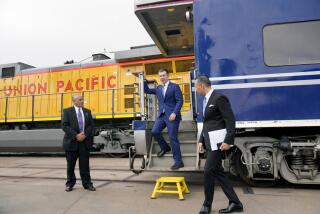L.A., Long Beach ports’ traffic rises 13% in January
International trade is surging again at the major local ports, suggesting that economic strength is building despite stubbornly high unemployment.
In January, the neighboring ports of Los Angeles and Long Beach, which together make up the country’s largest freight complex, handled 13% more cargo containers than a year earlier. Other signs of recovery: Longshoremen are getting more dock work, some Southern California warehouses are hiring again, and trucking and railroad freight movement has increased.
“It’s an exciting time to try to read the tea leaves,” said Art Wong, a spokesman for the Port of Long Beach. “These companies are placing their bets now on whether consumers are going to be buying this spring and throughout the rest of the year.”
International trade is an important indicator of the health of the U.S. economy. It’s also one of Southern California’s most important sources of well-paying blue-collar jobs, employing nearly 440,000 workers in Los Angeles, San Bernardino and Riverside counties.
At the Port of Los Angeles, the nation’s busiest harbor, 660,518 containers moved through the docks, up 15.3% from January 2010. The Long Beach port also posted strong increases despite losing a large tenant late last year, handling 474,960 containers in January, up 10.8%.
“It’s a great start for 2011. This is much stronger than we expected,” said Phillip Sanfield, spokesman for the Port of Los Angeles, who cautioned that the January numbers were strengthened by importers ordering early in anticipation of Chinese New Year celebrations, when that nation’s factories shut down for two weeks.
Sanfield said it was the port’s second-best January, after January 2007, but he added that double-digit increases are probably about to end.
“We are going to be going up against some of our best months ever this summer, so we are expecting the growth pace to slow,” Sanfield said.
Economists who keep track of traffic at the nation’s busiest seaports are expecting the double-digit growth to continue at least through February but slow after that. Import cargo volumes at the nation’s major container ports are expected to be up 11% this month, and the first half of the year will show an increase of about 6% compared with the first half of 2010, according to a report compiled for the National Retail Federation by Hackett Associates.
“Strong growth in 2010 has retailers cautiously optimistic that the economic recovery is finally taking hold,” said Jonathan Gold, vice president for supply chain and customs policy for the National Retail Federation. “While high unemployment and rising commodity prices are cause for concern, retailers are encouraged by six consecutive months of retail sales gains and improved consumer confidence.”
Employment at the L.A. and Long Beach ports is up in response to the increased traffic, according to daily employment dispatches for the International Longshore and Warehouse Union. On the wharves, employment was about 13% higher in January compared with the same month in 2010, the daily work dispatches show, and part-time “casuals,” who fill in when there aren’t enough union workers to go around, were getting work. In January 2010, casuals were mostly not needed at all.
But inland trade-related jobs will continue to lag behind trade increases until employer confidence returns, economists said.
In Los Angeles County, for example, full-time trade-related jobs were still on the decline at the end of 2010, with 329,700 employed, down from 335,600 at the end of 2009 and even further from the recent peak of 374,900 in 2005.
Only Riverside and San Bernardino counties showed trade-related job gains, and they were relatively modest, up about 2,000 positions to 109,900 in the two counties at the end of 2010 compared with 2009, said John Husing, whose firm, Economics and Politics Inc., tracks international trade.
Husing said that the Inland Empire was recovering faster in part because its 440 million square feet of warehouse and distribution-center space tends to be made up of newer and larger buildings compared with the 1 billion square feet of comparable space in Los Angeles County.
Trade employment numbers don’t reflect the growth in cargo movement because many companies have gotten more efficient in terms of how much work their employees generate, Husing said. In addition, employers are being careful about hiring as they await further proof of a sustained economic recovery.
“At this point in the cycle, they are hiring temporary workers until they are sure they are dealing with a new growth paradigm,” Husing said.
The nation’s trucking industry, while continuing to improve, is cautious.
The American Trucking Assn.’s For-Hire Truck Tonnage Index, a barometer of freight hauling across various kinds of cargo, increased to 111.6 in December, the highest level since September 2008.
“Fleets continue to tell me that freight volumes are very choppy — up one week but down the next. That is a trend that is likely to continue this year as the economy is not growing across the board yet,” said Bob Costello, chief economist for the group.
The nation’s major railroads are pulling more of their idled hardware back into service as freight levels increase. In January, monthly carloads rose 8% and 132,284 rail cars were taken out of storage. An additional 316,271 rail cars remained out of service, representing nearly 21% of the North American fleet, according to the Assn. of American Railroads.
More to Read
Inside the business of entertainment
The Wide Shot brings you news, analysis and insights on everything from streaming wars to production — and what it all means for the future.
You may occasionally receive promotional content from the Los Angeles Times.










